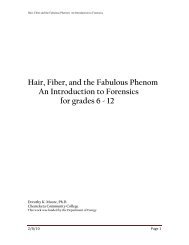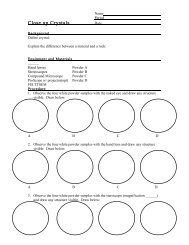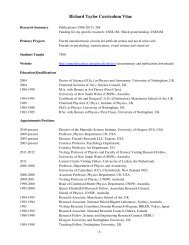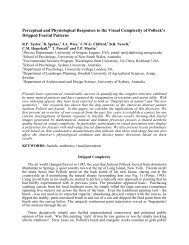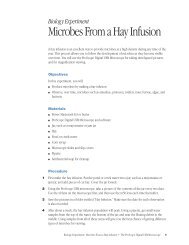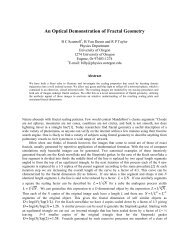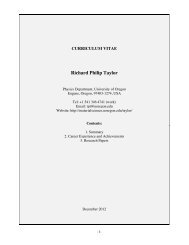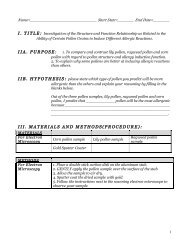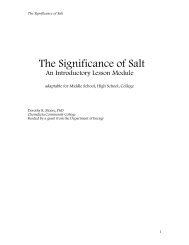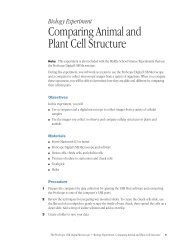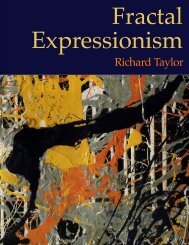December 2004 - Materials Science Institute - University of Oregon
December 2004 - Materials Science Institute - University of Oregon
December 2004 - Materials Science Institute - University of Oregon
You also want an ePaper? Increase the reach of your titles
YUMPU automatically turns print PDFs into web optimized ePapers that Google loves.
ARTIST’S CONCEPTION depicts how a tether system might operate on an exploratory mission<br />
to Jupiter and its moons.<br />
from the rotating Earth’s surface would<br />
continuously increase its angular inertia;<br />
therefore, its angular velocity would<br />
steadily decrease as it rose, to keep its angular<br />
momentum constant. This would<br />
compel the rising elevator and mass to increasingly<br />
drift west, which would cause<br />
the tether to bend, pulling the attached<br />
space station closer to the elevator and<br />
to Earth’s surface. If the cable did not<br />
snap under the stress, the station would<br />
steadily increase its eastward angular<br />
orbital velocity (again to keep the angular<br />
momentum constant) as it was being<br />
forced to descend diagonally along the<br />
stressed, increasingly bending tether. The<br />
descending station could possibly collide<br />
with the elevator simultaneously just as<br />
both strike the surface while attached<br />
to an again taut tether, stretching from<br />
its attachment point, 36,000 kilometers<br />
westward along the equator’s surface.<br />
Julian Kane<br />
H<strong>of</strong>stra <strong>University</strong><br />
LORENZINI AND SANMARTÍN REPLY: Ambrose<br />
worries about confusing students with<br />
the expression “centrifugal force,” a concern<br />
shared by pr<strong>of</strong>essors teaching fi rst-year undergraduate<br />
physics. This concern has led<br />
authors <strong>of</strong> textbooks (Physics, by Kane and<br />
Sternheim, 1983; Physics, by Cutnell and<br />
Johnson, 1989) to systematically avoid the<br />
term. Yet many pr<strong>of</strong>essional physicists do refer<br />
to “centrifugal forces” (for instance, Physics:<br />
Classical and Modern, by Gettys, Keller<br />
and Skove, 1989; the Nobel Prize–winning<br />
Richard Feynman in his Feynman Lectures<br />
on Physics, Vol. I). It is a valid concept within<br />
a rotating frame <strong>of</strong> reference. We phrased the<br />
article to imply such a frame but regret not<br />
mentioning it explicitly.<br />
The space elevator tether Kane refers to<br />
would actually have to be 144,000 kilometers<br />
long (four times longer than the altitude <strong>of</strong><br />
the geostationary orbit). The system’s mass<br />
and the cable tension would be so great an<br />
elevator with almost negligible mass with respect<br />
to the system, moving along the cable<br />
at a reasonable speed toward geostationary<br />
orbit, would bend the tether to a small extent<br />
but not tip the massive system over. The<br />
conservation <strong>of</strong> angular momentum is maintained<br />
by a slight slowing <strong>of</strong> Earth’s rotation.<br />
PROBLEMS WITH BUNKER BUSTERS<br />
Michael Levi’s article “Nuclear Bunker<br />
Buster Bombs” doesn’t mention the<br />
most important factor in the success<br />
<strong>of</strong> these weapons: reliable intelligence.<br />
How would we know the bunker’s location<br />
(within tens <strong>of</strong> meters) as well as its<br />
depth, geology and degree <strong>of</strong> hardening<br />
and whether it is a command center or<br />
contains biological or chemical munitions?<br />
Even troops on the ground may<br />
require months to locate targets. Before<br />
the Iraq invasion, <strong>of</strong>fi cials spoke with<br />
certainty about the location and nature<br />
<strong>of</strong> the country’s weapons <strong>of</strong> mass<br />
destruction, yet none have been found.<br />
Given the diffi culty in obtaining reliable<br />
intelligence, the viability <strong>of</strong> these weapons<br />
is questionable.<br />
John Howard<br />
Ventura, Calif.<br />
Letters<br />
EMPIRIC- OR FAITH-BASED PHYSICS?<br />
Regarding Laurence M. Krauss’s comment<br />
about the challenge <strong>of</strong> teaching<br />
evolution in schools [“Questions That<br />
Plague Physics,” an interview by Claudia<br />
Dreifus]: I am always shocked to<br />
hear about the educational situation in<br />
the U.S. It is incredible that fundamentalists<br />
who are science illiterates have a<br />
say in what should be taught. I wonder<br />
how long the U.S. populace can afford<br />
this poor grounding in science. Surely<br />
the government’s bad record in curtailing<br />
energy consumption and pollution<br />
is related to the widespread lack <strong>of</strong> a<br />
proper science education.<br />
Gerhard Buzas<br />
Innsbruck, Austria<br />
The Krauss interview reveals a fuzzy<br />
distinction between science and science<br />
fi ction. Krauss says that scientists<br />
empirically prove things and “toss out<br />
things that have been disproved.” It<br />
seems that testing and tossing may be<br />
needed for notions such as string theory<br />
and extra dimensions. Until these<br />
theories can be confi rmed with observations,<br />
they remain mere mathematical<br />
musings, good only as a challenge<br />
for students. The danger is that esoteric<br />
theories could become accepted as fact<br />
solely on the basis <strong>of</strong> the author’s status,<br />
which brings us perilously close to<br />
the power <strong>of</strong> the priesthood and faithbased<br />
physics.<br />
Colin Gordon<br />
Santa Barbara, Calif.<br />
ERRATA In “Nuclear Bunker Buster Bombs,”<br />
by Michael Levi, a 10-kiloton nuclear weapon<br />
detonated one meter underground in soil<br />
would destroy targets within 50 meters, not<br />
fi v e m e t e r s .<br />
In “Electrodynamic Tethers in Space,” by<br />
Enrico Lorenzini and Juan Sanmartín, Kevlar<br />
was described as a carbon fi ber; it is an aramid<br />
(short for “aromatic polyamide”) fi ber.<br />
“SETI at Home” [Data Points, News Scan]<br />
should have reported the number <strong>of</strong> countries<br />
participating in SETI as 226 countries,<br />
possessions and other territories.<br />
14 SCIENTIFIC AMERICAN DECEMBER <strong>2004</strong><br />
COPYRIGHT <strong>2004</strong> SCIENTIFIC AMERICAN, INC.<br />
ALFRED T. KAMAJIAN




